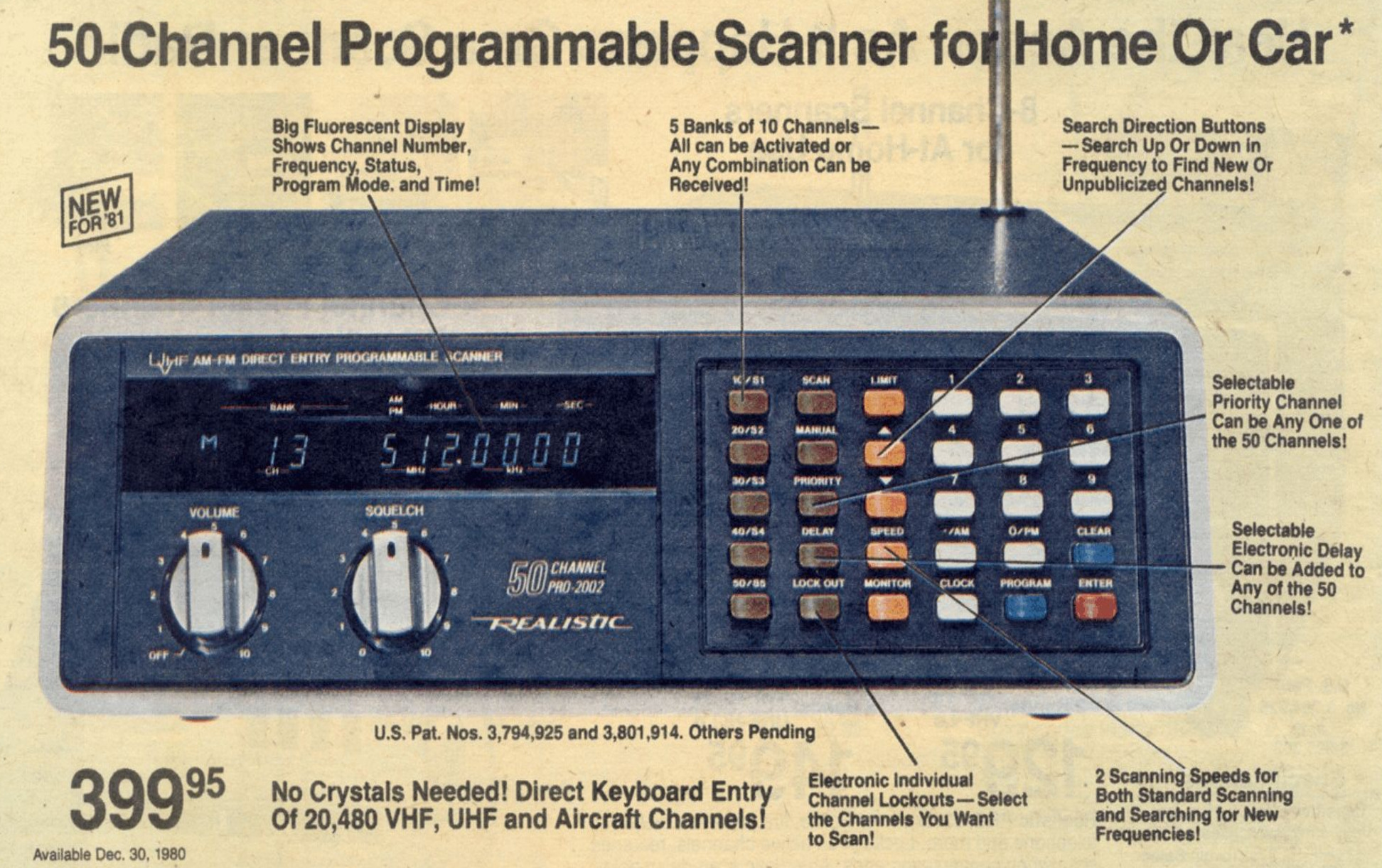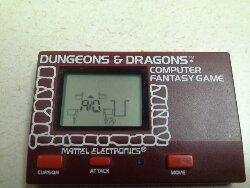Continuing the countdown, I decided it would be best to break up the summary posts into five day block. Doing so will prohibit the need to keep scrolling, just to get to what’s important… details of the newest posting.
Then again, many of you actually reminiscing about these items because you also remember when you were younger, you’re probably already used to scrolling for a long time on some web pages to scroll to your year of birth in an age dropdown. 🙂
Don’t forget to start this series from the beginning if you haven’t done so already.
Day 6: Big Trak
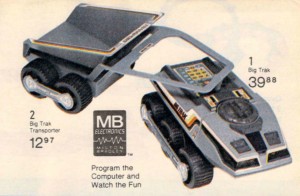
I have always been interested in automation. Part science and part magic, especially when you don’t know how it really works. No worries. This was such a cool toy back in 1979. About the size of a cinder block, The Big Trak is a battery draining, programmable automaton which will go anywhere you THINK you’re programming it to go to… even tumbling down the stairs to do so.
While the concept is astounding, execution leaves a little bit to be desired. The Big Trak is programmed by you to go in any direction for a given period or distance through a series of commands you type in on its membrane keyboard. However, it lacks precision in its moves and turns. So if you measure out the distance and directions you want the thing to go, it will not always execute that way. Right angle turns aren’t always executed at 90 degree intervals, even though that’s its concept of operation. This tends to cause the Big Trak to run into walls or end up tumbling down the stairs, also due to the lack of avoidance sensors.
Those linitations are part of its charm though. It doesn’t change the fact that it’s still fun to play with.
Day 7 : Head-to-Head Electronic Football
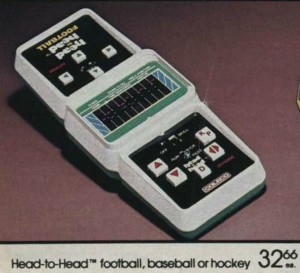
One of the most popular electronic games back in 1980 are the sport based LED display games. These games had very simple “graphics” where players were represented on a silkscreen display through the use of tiny dots or dashes of Light Emitting Diode pixels. Among the sports represented by these games are basketball, baseball, hockey, and probably the most popular… FOOTBALL!
Mattel Electronics made the most famous LED football game. One that had been re-released recently as a retro handheld. However, only one person can play that at a time. Even if you switch off with someone else between the Home and Away team, it’s still you against the computer.
Coleco responded by creating a head-to-head version of Football, along with other sports games. The great thing about head-to-head play is that you get to play against another person, along with the computer, so there is an element of human rivalry at play.
I guess it was good for parents of two children because the Coleco Head-to-Head games save them money by allowing them to buy one gift for two people. 🙂
Day 8: Atari Stunt Cycle (a.k.a. Sears Motocross) (1977)
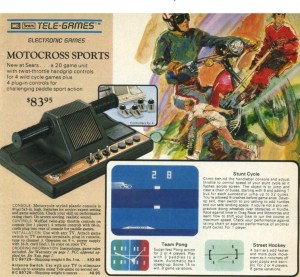
Back in 1977, just at the cusp of the Atari 2600 craze, the home Pong game craze was beginning to wear thin. While the Atari 2600 system helped change the monotony of game variations, manufacturers augmented their standalone Pong games with additional programming. One such game system was the Atari Stunt Cycle.
Shown in the picture is the Sears version of the game, called Motocross. It was common for Sears to buy the rights from other manufacturers to put their own name on some products. I’ve chosen to use the Sears version here because I have been doing my research using Sears Wishbook catalogs. In gameplay, the Atari and Sears versions are identical.
Not only did this system offer up to four player pong, hockey, squash, etc., like the other Pong games did back in the day, the premiere game is a stunt cycle jump game. The gameplay was similar to an Atari arcade game at the time, where you drove a motorcycle that passed left to right across the screen three times. Each pass across the screen is 1/3 of the entire trip toward a line of busses that you have to safely jump at the right speed, or risk a crash. After each jump, another bus gets added. The controls are motorcycle handlebars. The right handle is the throttle. You have to pick up speed during the game when you need to jump a larger bus count. A quick flick of the throttle causes the speed shift to occur.
I picked this item for this retro wishlist series because I knew someone who got one for Christmas that year, and it would have been cool to have one of my own.
Day 9: Heathkit GC-1107 Digital Alarm Clock (1977)
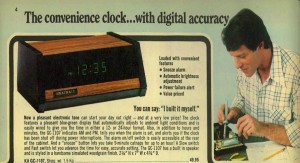
October 31, 1977 is the first Halloween I stopped going on the annual Trick-or-Treat event. It was on this day that I bought a Radio Shack AM Transmitter kit, and then became fully engaged in hobby electronics. A hobby that has continued to exist to this day. Shortly after that fateful day, I discovered Heathkit catalogs. Every single one of the kits fascinated me, even those kits whose purpose I did not understand. I had pointed out to my parents some “wish kits” that I would have wanted to buy for myself. And on Christmas that year, I received my very first Heathkit kit, the GC-1107 VFD digital alarm clock.
I was fascinated by the kit building guide and how easy it was to assemble, solder, and test the clock through all stages in its assembly, which was probably the reason why it worked the first time. The kit allowed me to enhance my knowledge of electronics, and give me important training and tips on proper soldering techniques. I even learned at a later date that I could add a relay, tapped off of a clock chip pin, which would be activated when the alarm goes off. I fancied the idea of making the relay switch on an electrical socket, to turn on my bedroom light in the morning, but I was still not up to par in the hobby to be working directly with main line household current. I’ve focused more on electronic systems that were powered by batteries or DC power supplies.
I still own this clock to this day. Long ago, I put it away in lieu of using a Radio Shack talking alarm clock I got in the mid 1980s. When I later found the clock again and plugged it in, it was stuck in a time set mode where it was advancing two minutes per second all by itself, which is one of the ways you set the clock using its underside switches. Even after unsoldering that switch, it still does the same thing. I’m guessing it has a bad clock chip, which is a unique part, and is pretty much the entire brains of the system.
Day 10: Heathkit 5MHz Oscilloscope (1978)
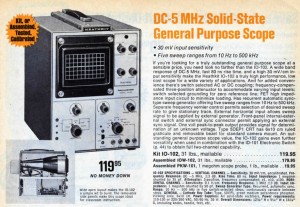
Continuing along the Heathkit line momentarily, this was an item I believe I got on Christmas 1978. It may have been in 1977, but I don’t quite remember if I got it when I got the alarm clock kit mentioned in yesterday’s post. However, I did get it, along with some other electronics testing equipment on the same Christmas day.
This is the Heathkit IO-102 5MHz oscilloscope. By today’s standards (and even perhaps yesterday’s standards) it is not a very powerful scope. A more powerful scope would support signal bandwidths greater than 10MHz. However, it was still an oscilloscope, and it had a purpose. It allows one to “see” electricity in action. All oscilloscopes were capable of watching audio signals quite easily. With the right input to the scope, you could talk into a microphone and watch the exact waveform of your speech on the screen. That was its best novelty. It was also capable of looking at signals throughout the AM radio broadcasting bands because their frequencies ranged from 540KHz to 1.6MHz. During the days this oscilloscope was on the market, computers were operating around 1MHz, so this scope could also be used to look at the presence of activity in the computer, along with verifying the CPU clock speed.
But this oscilloscope wasn’t new when I got it. In fact, in the year I got it, this model wasn’t even being sold anymore. Heathkit had a newer model in their catalogs. This one was sort of a hand-me-down that my parents bought for me from someone they knew. But I was absolutely fine with that. It was new to me, and it was cool to have as part of my ever growing collection of electronics test equipment.
Go to the next article in this series.


